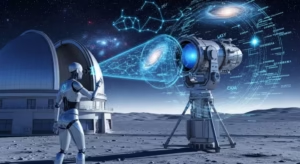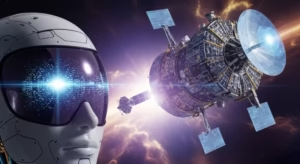AI in Space Exploration: How Machines Are Changing Our View of the Universe

AI in space exploration is revolutionizing our understanding of the universe. This blog post delves into the significant role AI plays in modern space missions, highlighting how AI and machine learning are transforming astronomy through enhanced data analysis and pattern recognition. Moreover, it explores the impact of deep space AI technologies, enabling spacecraft to make real-time decisions and facilitate autonomous operations in uncharted territories. As we discuss the future of space exploration, the article prompts readers to consider their next steps in engaging with these groundbreaking advancements. With AI at the forefront, humanity’s quest for knowledge of the cosmos is set to reach new heights, making our exploration endeavors more efficient and insightful than ever before.
Unveiling The Role Of AI In Space Exploration

AI in space exploration is revolutionizing how we understand and navigate the cosmos. Advanced algorithms analyze vast amounts of astronomical data, aiding in the discovery of exoplanets and providing insights into cosmic phenomena. The application of AI in NASA missions exemplifies how intelligent systems enhance our exploration capabilities. From real-time decision-making during space missions to predictive modeling, AI is proving to be an invaluable asset in modern astronomy.
Benefits of AI in Space Exploration
- Data Processing Efficiency: AI can process and analyze vast datasets faster than traditional methods.
- Improved Accuracy: Machine learning techniques enhance the precision of discoveries and observations.
- Automated Operations: AI systems can autonomously manage spacecraft operations, reducing human error.
- Cost-Effectiveness: AI reduces the need for extensive human resources, lowering mission costs.
- Enhanced Predictive Modeling: It helps in making accurate forecasts about space weather and other phenomena.
- Real-Time Decision Making: AI algorithms allow for immediate responses to challenges encountered in space.
As we explore deeper into the universe, the relevance of AI in space exploration continues to grow. Its ability to adapt and learn from intricate data patterns makes it a pivotal component in unraveling the mysteries of space. The synergy of artificial intelligence and human ingenuity will undoubtedly shape the future of our cosmic endeavors.
How AI And Machine Learning Are Transforming Astronomy

As we venture deeper into the universe, the role of AI in space exploration becomes increasingly vital. With the amount of data generated by telescopes and space missions skyrocketing, traditional methods of analysis are insufficient. This is where machine learning in astronomy takes center stage, facilitating unprecedented insights into cosmic phenomena. By automating observations and analyzing vast datasets, AI technologies are turning challenges into opportunities for exploration and discovery.
One of the most significant impacts of AI and machine learning is their application in various astronomy projects. From detecting exoplanets to mapping cosmic structures, these technologies enhance our ability to explore and understand the universe. For instance, space missions leverage AI algorithms to identify patterns in the data, such as cosmic rays or gravitational waves, that human researchers might miss. The integration of AI allows astronomers to effectively manage and interpret the colossal amounts of information that are generated daily.
| Application | Description | Benefits |
|---|---|---|
| Exoplanet Detection | AI analyzes light curves to identify potential planets. | Increased accuracy and efficiency in identifying new exoplanets. |
| Data Classification | Machine learning algorithms classify various celestial objects. | Automated sorting of vast datasets speeds up research. |
| Astrophysical Simulation | AI models simulate cosmic events to predict behaviors. | Helps in understanding complex phenomena without extensive physical experiments. |
Machine learning techniques are at the forefront of these advancements, enabling astronomers to refine and enhance their investigations. By utilizing methods like supervised learning, unsupervised learning, and deep learning, researchers can develop models that understand the intricate patterns within astronomical data. This application of AI leads to more accurate predictions and contributes substantially to groundbreaking discoveries in the field.
Steps To Implement AI In Astronomy
- Identify specific challenges within existing astronomical processes.
- Gather relevant data from telescopes and previous space missions.
- Choose appropriate machine learning models tailored to the challenges.
- Train the AI models using historical and current data.
- Test and validate the AI results against established benchmarks.
- Integrate AI findings into mainstream astronomical research.
- Continuously update models with new data and insights.
As we harness the capabilities of AI space missions and machine learning in astronomy, we unlock new avenues for exploration that can transform our understanding of the cosmos. With each advancement, we move closer to answering age-old questions and uncovering the mysteries that the universe holds. The synergy between AI technologies and astronomy is set to propel the field into an exciting new era, brimming with possibilities.
Exploring The Impact Of Deep Space AI Technologies

The integration of deep space AI technologies has ushered in a new era in our understanding of the universe. As missions extend further into the cosmos, artificial intelligence plays a pivotal role in processing vast amounts of data, aiding scientists in making significant discoveries beyond our planet. These innovative technologies are not just enhancing the capabilities of spacecraft but also revolutionizing how we analyze cosmic phenomena and interact with distant worlds.
Key Deep Space AI Technologies
- Autonomous Navigation Systems
- Data Analysis Algorithms
- Predictive Modeling Tools
- Deep Learning Image Processing
- Robotic Mission Systems
- Natural Language Processing Interfaces
One of the major impacts of AI in space exploration is its ability to solve complex problems encountered during missions. By utilizing machine learning algorithms, spacecraft can autonomously adjust their trajectories, enhance their operational efficiency, and even diagnose and correct themselves in real-time. However, this technological evolution does not come without its challenges, where factors such as data transmission delays and hardware limitations in deep space environments require innovative solutions.
Challenges And Solutions
As the reliance on deep space AI grows, so do the challenges that accompany its integration. The need for robust systems that can operate under harsh conditions is paramount, as well as the necessity for advanced algorithms capable of real-time decision-making. Solutions are being developed, including advancements in hardware resilience and smarter software that can learn from unexpected situations, ensuring that our exploration efforts remain on the cutting edge of technology.
The Future Of Space Exploration: Your Next Steps

As we delve deeper into the cosmos, the role of AI in space exploration continues to expand, reshaping our understanding of the universe. Innovations in artificial intelligence facilitate not only data analysis but also autonomous decision-making in space missions. This revolution in technology is equipping space agencies and researchers with tools to tackle complex challenges and push the boundaries of human knowledge further than ever before. With this rapidly evolving landscape, it’s crucial to consider how enthusiasts and professionals alike can engage with AI and its capabilities in the field of space exploration.
Actionable Steps For Engaging With AI In Space
- Explore educational resources about AI technologies and their applications in space.
- Participate in workshops or webinars focused on AI and space missions.
- Join online communities and forums that discuss AI in space exploration.
- Collaborate with professionals already working in AI and aerospace sectors.
- Experiment with AI tools and software relevant to space research.
- Stay updated with recent advancements and case studies in AI applications.
By taking these steps, you can become an active participant in shaping the future of space exploration. The integration of AI in space exploration is not just a technological advancement; it signals a new era of discovery and understanding that could unveil answers to some of humanity’s oldest questions. Whether you are a student, researcher, or simply a space enthusiast, embracing these actionable steps will provide a solid foundation for contributing to this exciting field.
Briefing Document: The Transformative Role of AI in Space Exploration
I. Executive Summary
Artificial Intelligence (AI) and Machine Learning (ML) are profoundly revolutionizing space exploration and astronomy. By enabling unprecedented efficiency in data processing, enhancing accuracy in discoveries, and facilitating autonomous operations, AI is becoming an indispensable tool for understanding and navigating the cosmos. Its application spans from exoplanet detection and cosmic mapping to real-time decision-making for deep space missions, promising a future of more insightful, efficient, and cost-effective cosmic endeavors.
II. Main Themes and Key Insights
A. Revolutionizing Understanding and Navigation of the Cosmos
AI in space exploration is fundamentally changing how humanity interacts with the universe. The “AI in Space Exploration: How Machines Are Changing Our View of the Universe” source highlights that AI “is revolutionizing our understanding of the universe.” This is primarily achieved through:
- Enhanced Data Analysis and Pattern Recognition: AI algorithms can analyze vast datasets from telescopes and space missions “faster than traditional methods,” identifying patterns that human researchers might overlook, such as “cosmic rays or gravitational waves.”
- Real-Time Decision Making: AI enables spacecraft to make “real-time decisions” and “autonomously adjust their trajectories, enhance their operational efficiency, and even diagnose and correct themselves.” This is crucial for deep space missions where communication delays are significant.
- Autonomous Operations: AI systems can “autonomously manage spacecraft operations, reducing human error,” leading to more efficient and safer missions.
B. Significant Benefits of AI in Space Exploration
The integration of AI brings numerous advantages to space exploration, making missions more effective and sustainable:
- Data Processing Efficiency: AI can “process and analyze vast datasets faster than traditional methods,” a critical capability given the “amount of data generated by telescopes and space missions skyrocketing.”
- Improved Accuracy: Machine learning techniques “enhance the precision of discoveries and observations,” leading to more reliable scientific findings.
- Cost-Effectiveness: By reducing “the need for extensive human resources,” AI helps in “lowering mission costs.”
- Enhanced Predictive Modeling: AI assists in “making accurate forecasts about space weather and other phenomena,” which is vital for mission planning and safety.
C. Transforming Astronomy through Machine Learning
Machine learning is at the forefront of advancements in astronomy, enabling deeper insights into cosmic phenomena.
- Exoplanet Detection: AI “analyzes light curves to identify potential planets,” significantly increasing “accuracy and efficiency in identifying new exoplanets.”
- Data Classification: ML algorithms “classify various celestial objects,” automating the “sorting of vast datasets” and speeding up research.
- Astrophysical Simulation: AI models “simulate cosmic events to predict behaviors,” aiding in understanding complex phenomena without extensive physical experiments.
- Handling Vast Datasets: Traditional analysis methods are “insufficient” for the immense volume of data generated, making ML “pivotal component in unraveling the mysteries of space.”
D. Impact of Deep Space AI Technologies
As missions venture further into the cosmos, deep space AI becomes critical for addressing unique challenges:
- Solving Complex Problems: Deep space AI enables spacecraft to autonomously handle unforeseen issues.
- Key Technologies: This includes “Autonomous Navigation Systems,” “Data Analysis Algorithms,” “Predictive Modeling Tools,” “Deep Learning Image Processing,” “Robotic Mission Systems,” and “Natural Language Processing Interfaces.”
- Challenges and Solutions: Operating in harsh deep space environments presents challenges like “data transmission delays and hardware limitations.” Solutions involve “advancements in hardware resilience and smarter software that can learn from unexpected situations.”
III. The Future of Space Exploration and Engagement
AI is not just a technological advancement but “signals a new era of discovery and understanding” that could answer humanity’s oldest questions. The future of space exploration is inextricably linked with AI, requiring continuous engagement and adaptation.
For individuals and professionals, the source suggests “Actionable Steps For Engaging With AI In Space”:
- Explore educational resources.
- Participate in workshops and webinars.
- Join online communities and forums.
- Collaborate with professionals in AI and aerospace.
- Experiment with AI tools and software.
- Stay updated with recent advancements.
By actively engaging with AI, individuals can contribute to “shaping the future of space exploration,” fostering a synergy between “artificial intelligence and human ingenuity” that “will undoubtedly shape the future of our cosmic endeavors.”
Artificial intelligence / AI in Science & Technology
🎧 Listen to the Podcast
Want to explore this topic in more depth? Listen to the full podcast for more insights and expert commentary.
▶️ Play on Google DriveNo sign-up needed — just click and listen.
How does AI enhance data processing and analysis in astronomy?
AI and machine learning are vital for transforming astronomy due to the massive amounts of data generated by telescopes and space missions. AI algorithms can process and analyze these vast datasets much faster and with greater accuracy than traditional methods. They are crucial for tasks like detecting exoplanets by analyzing light curves, classifying various celestial objects, and simulating cosmic events to predict behaviors, often identifying patterns that human researchers might miss.
What are the key benefits of integrating AI into space missions?
The benefits of AI in space exploration are numerous and significant. They include increased data processing efficiency, improved accuracy in discoveries and observations, and the ability to automate spacecraft operations, which reduces human error and lowers mission costs by decreasing the need for extensive human resources. AI also enhances predictive modeling for phenomena like space weather and enables real-time decision-making for immediate responses to challenges encountered in space.
How do deep space AI technologies contribute to exploration?
Deep space AI technologies are ushering in a new era of cosmic understanding by enabling spacecraft to operate effectively far from Earth. These technologies, including autonomous navigation systems, advanced data analysis algorithms, predictive modeling tools, deep learning image processing, robotic mission systems, and natural language processing interfaces, allow spacecraft to autonomously adjust trajectories, enhance operational efficiency, and even self-diagnose and correct issues in real-time. This is crucial for solving complex problems encountered during extended missions.
What role does machine learning play in astronomical discoveries?
Machine learning is at the forefront of advancements in astronomy. Techniques like supervised, unsupervised, and deep learning allow researchers to develop models that can understand intricate patterns within astronomical data. This leads to more accurate predictions and contributes substantially to groundbreaking discoveries, such as identifying new exoplanets or mapping cosmic structures, by effectively managing and interpreting the colossal amounts of information generated daily.
What are the main challenges associated with implementing deep space AI, and how are they being addressed?
Implementing deep space AI comes with significant challenges, primarily the need for robust systems that can operate under harsh conditions and advanced algorithms capable of real-time decision-making despite data transmission delays and hardware limitations in deep space environments. Solutions being developed include advancements in hardware resilience and smarter software that can learn from unexpected situations, ensuring the continued cutting-edge nature of exploration efforts.
How does AI facilitate autonomous operations in space?
AI systems are designed to autonomously manage spacecraft operations, significantly reducing reliance on human intervention and minimizing the potential for human error. This includes tasks like autonomous navigation, real-time adjustments of trajectories, self-diagnosis, and correction of issues. This capability is crucial for missions venturing into uncharted territories where real-time human command and control are not feasible due to communication delays.




